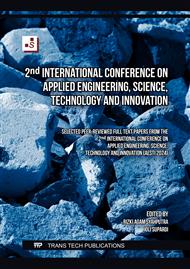[1]
Badan Pusat Statistik Jawa Tengah, Provinsi Jawa Tengah dalam Angka, vol. 49. Jawa Tengah: Badan Pusat Statistik Jawa Tengah, 2024.
DOI: 10.31002/rep.v5i2.1919
Google Scholar
[2]
Sekretariat Jenderal Dewan Energi, Outlook Energi Indonesia. 2023.
Google Scholar
[3]
D. Kallehave, B. W. Byrne, C. LeBlanc Thilsted, and K. K. Mikkelsen, "Optimization of monopiles for offshore wind turbines," Phil. Trans. R. Soc. A., vol. 373, no. 2035, p.20140100, Feb. 2015.
DOI: 10.1098/rsta.2014.0100
Google Scholar
[4]
C. Menéndez-Vicente, S. López-Querol, S. Bhattacharya, and R. Simons, "Numerical study on the effects of scour on monopile foundations for Offshore Wind Turbines: The case of Robin Rigg wind farm," Soil Dynamics and Earthquake Engineering, vol. 167, p.107803, Apr. 2023.
DOI: 10.1016/j.soildyn.2023.107803
Google Scholar
[5]
N. M. Nasab, J. Kilby, and L. Bakhtiaryfard, "Analysis and Design of Monopile Foundations for Offshore Wind and Tidal Turbine Structures," Water, vol. 14, no. 21, p.3555, Nov. 2022.
DOI: 10.3390/w14213555
Google Scholar
[6]
L. Arany, S. Bhattacharya, J. Macdonald, and S. J. Hogan, "Design of monopiles for offshore wind turbines in 10 steps," Soil Dynamics and Earthquake Engineering, vol. 92, p.126–152, Jan. 2017.
DOI: 10.1016/j.soildyn.2016.09.024
Google Scholar
[7]
Badan Meteorologi, Klimatologi, dan Geofisika (BMKG), "Ocean Forecast System (OFS)." 2023.
DOI: 10.29408/geodika.v4i1.1915
Google Scholar
[8]
Energieschweiz, "Kalkulator Weibull." Accessed: Jun. 10, 2024. [Online]. Available: https://wind-data.ch/tools/weibull.php
Google Scholar
[9]
R. Gupta and A. Biswas, "Wind data analysis of Silchar (Assam, India) by Rayleigh's and Weibull methods," 2010.
Google Scholar
[10]
T. R. Ayodele, A. A. Jimoh, J. L. Munda, and J. T. Agee, "Statistical analysis of wind speed and wind power potential of Port Elizabeth using Weibull parameters," J. energy South. Afr., vol. 23, no. 2, p.30–38, May 2012.
DOI: 10.17159/2413-3051/2012/v23i2a3160
Google Scholar
[11]
S. Bhattacharya, Design of Foundations for Offshore Wind Turbines, 1st ed. Wiley, 2019.
Google Scholar
[12]
IEC 61400-1. in Third edition. 2005.
Google Scholar
[13]
Y.-S. Kuo, M. Achmus, and K. A. Rahman, "Minimum Embedded Length of Cyclic Horizontally Loaded Monopiles," Journal of Geotechnical and Geoenvironmental Engineering, vol. 138, no. 3, 2011.
DOI: 10.1061/(asce)gt.1943-5606.0000602
Google Scholar
[14]
S. Bhattacharya, G. Nikitas, L. Arany, and N. Nikitas, "Soil-Structure Interactions (SSI) for Offshore Wind Turbines," Agustus 2017.
DOI: 10.1049/etr.2016.0019
Google Scholar
[15]
P. Kucharczyk, A. Rizos, S. Münstermann, and W. Bleck, "Estimation of the endurance fatigue limit for structural steel in load increasing tests at low temperature.," Fatigue Fract Eng Mater Struct, 2012.
DOI: 10.1111/j.1460-2695.2011.01656.x
Google Scholar
[16]
R. Obrzud and A. Truty, The Hardening Soil Model A Practical Guidebook. Switzerland: ZSoil, 2020.
Google Scholar
[17]
T. Adayat, "Determination of the Undrained Shear Strength of Sensitive Clay Using Some Laboratory Soil Data," Redfame Publishing, vol. 8, 2021.
Google Scholar
[18]
S. K. Thota, T. D. Cao, and F. Vahedifard, "Poisson's Ratio Characteristic Curve of Unsaturated Soils," Journal of Geotechnical and Geoenvironmental Engineering, 2020.
DOI: 10.1061/(asce)gt.1943-5606.0002810
Google Scholar
[19]
IEC 61400-1, Wind Energy Generation System - Part 1 : Design Requirement, Geneva, Switzerland., 2019.
Google Scholar
[20]
M. T. Davisson and S. Prakash, "A Review of Soil-Pole Behavior," Committ ee on Stress Distributi on in Earth Masses, 1963.
Google Scholar
[21]
M. H. Patel, Dynamics of Offshore Structure. Butterworth & Co., 1989.
Google Scholar
[22]
API, Recommended Practice for Planning, Designing and Constructing Fixed Offshore Platforms—Working Stress Design. Washington DC: American Petroleum Institute, 2007.
DOI: 10.2523/20837-ms
Google Scholar
[23]
Det Norske Veritas, Fatigue Design of Offshore Steel Structures, 2011.
Google Scholar



